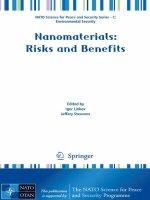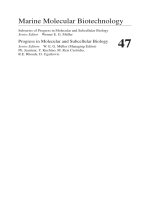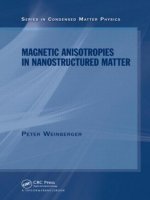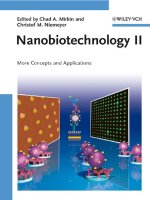- Trang chủ >>
- Khoa Học Tự Nhiên >>
- Vật lý
biosilica in evolution, morphogenesis, and nanobiotechnology, 2009, p.421
Bạn đang xem bản rút gọn của tài liệu. Xem và tải ngay bản đầy đủ của tài liệu tại đây (19.83 MB, 421 trang )
Marine Molecular Biotechnology
Subseries of Progress in Molecular and Subcellular Biology
Series Editor Werner E. G. Müller
Progress in Molecular and Subcellular Biology
Series Editors W. E. G. Müller (Managing Editor)
Ph. Jeanteur, Y. Kuchino, M. Reis Custódio,
R.E. Rhoads, D. Ugarkovic
47
Volumes Published in the Series
Progress in Molecular Subseries:
and Subcellular Biology Marine Molecular Biotechnology
Volume 33
Silicon Biomineralization
W.E.G. Müller (Ed.)
Volume 34
Invertebrate Cytokines
and the Phylogeny of Immunity
A. Beschin and W.E.G. Müller (Eds.)
Volume 35
RNA Trafficking and Nuclear Structure
Dynamics
Ph. Jeanteur (Ed.)
Volume 36
Viruses and Apoptosis
C. Alonso (Ed.)
Volume 38
Epigenetics and Chromatin
Ph. Jeanteur (Ed.)
Volume 40
Developmental Biology of Neoplastic
Growth
A. Macieira-Coelho (Ed.)
Volume 41
Molecular Basis of Symbiosis
J. Overmann (Ed.)
Volume 44
Alternative Splicing and Disease
Ph. Jeanlevr (Ed.)
Volume 45
Asymmetric Cell Division
A. Macieira Coelho (Ed.)
Volume 37
Sponges (Porifera)
W.E.G. Müller (Ed.)
Volume 39
Echinodermata
V. Matranga (Ed.)
Volume 42
Antifouling Compounds
N. Fusetani and A.S. Clare (Eds.)
Volume 43
Molluscs
G. Cimino and M. Gavagnin (Eds.)
Volume 46
Marine Toxins as Research Tools
N. Fusetani and W. Kem (Eds.)
Volume 47
Biosilica in Evolution, Morphogenesis,
and Nanobiotechnology
W.E.G. Müller and M.A. Grachev (Eds.)
Werner E.G. Müller • Mikhael A. Grachev
Editors
Biosilica in Evolution,
Morphogenesis, and
Nanobiotechnology
Case Study Lake Baikal
ISSN 1611-6119
ISBN 978-3-540-88551-1 e-ISBN 978-3-540-88552-8
DOI 10.1007/978-3-540-88552-8
Library of Congress Catalog Number: 2008938188
© 2009 Springer-Verlag Berlin Heidelberg
This work is subject to copyright. All rights reserved, whether the whole or part of the material is
concerned, specifically the rights of translation, reprinting, reuse of illustrations, recitation, broadcasting,
reproduction on microfilm or in any other way, and storage in data banks. Duplication of this publication
or parts thereof is permitted only under the provisions of the German Copyright Law of September, 9,
1965, in its current version, and permission for use must always be obtained from Springer-Verlag.
Violations are liable for prosecution under the German Copyright Law.
The use of general descriptive names, registered names, trademarks, etc. in this publication does not
imply, even in the absence of a specific statement, that such names are exempt from the relevant protective
laws and regulations and therefore free for general use.
Product liability: The publisher cannot guarantee the accuracy of any information about dosage and
application contained in this book. In every individual case the user must check such information by
consulting the relevant literature.
Cover design: WMXDesign, Heidelberg, Germany
Printed on acid-free paper
9 8 7 6 5 4 3 2 1
springer.com
Editors
Prof. Dr. Werner E. G. Müller
Universität Mainz
Inst. Physiologische Chemie
Abt. Angewandte
Molekularbiologie
Duesbergweg 6
55099 Mainz
Germany
wmueller@ uni-mainz.de
Dr. Mikhael A. Grachev
Russian Academy of Sciences
Siberian Branch
Limnological Institute
Ulan-Batorskaya st. 3
Irkutsk
Russia 664033
Foreword
Lake Baikal, the oldest (>24 million years), deepest (1,637 m) and most volumi-
nous lake on Earth, comprising one-fifth of the world’s unfrozen freshwater, har-
bors the highest number of known endemic animals in a freshwater lake. Until
recently, it remained enigmatic why such a high diversity evolved in this closed and
isolated lake. Focusing on sponges (phylum Porifera) as examples, some answers
have produced a deeper understanding of the evolutionary forces that have driven
this process. The most likely scenarios are outlined in this volume, explaining the
high rate of evolution/diversification of Baikalian sponge species, especially focus-
ing on their method of reproduction and their specific habitat with its extreme
temperature and particular chemical composition. A further trigger of evolution of
the endemic sponges in Lake Baikal may be their sophisticated symbiotic relation-
ship with unicellular autotrophic eukaryotes. As a basis for understanding the
exceptional habitat, the geological history of the lake and its surrounding basins is
described in greater detail. Another exciting finding is that (almost) all sponge spe-
cies in Lake Baikal harbor mobile genetic elements (retrotransposons) which have
been implicated in the endemic progress during evolution.
It is likewise remarkable that the Baikalian sponges are characterized by a dis-
tinct and elaborate body plan which characterizes them as the most subtle freshwa-
ter sponges on Earth. The basic characteristics of the body plan construction are
given with the main emphasis on the organization, construction, and association of
the needle-like skeletal elements, the spicules. It is further highlighted that the basis
for the exceptional morphogenetic organization of the sponges in Lake Baikal must
be seen in the expression of those genes which result in the synthesis of proteins
governing the synthesis of spicules and their associated proteins. In particular, by
comparing sponge species in lakes adjacent, but not connected, to Lake Baikal, it
became apparent what a high degree of morphological construction their sponges
have reached.
The inorganic material from which spicules are made is silica, a material which
has recently gained increasing attention. Here, the siliceous sponges in general and
the Lake Baikal (siliceous) sponges in particular, are featured for their property to
synthesize polymeric silica enzymatically. The key enzyme involved in this process
is silicatein which exists in the endemic sponges of Lake Baikal as a family of more
than five different members. No other sponge taxon comprises such a high poly-
v
vi Foreword
morphism, thus qualifying the Lake Baikal species as exceptional with respect to
their genetic toolkit for silica formation. In order to successfully approach the
exploitation of this unique property in a sustainable way, and by applying modern
molecular biology and cell biology techniques, the sponge silicateins have been
prepared in a recombinant way in bacteria.
Based on these findings, it is now the challenge to apply the process of enzy-
matic silica formation for the fabrication of biosilica-based materials used, e.g., in
biomedicine. A major breakthrough came recently with experiments which showed
that silicatein can be immobilized on inorganic matrices as well as on organic poly-
mer layers through a linker molecule, comprising a nitrilotriacetic acid group which
binds via nickel ions to histidine-tagged silicatein. The immobilized enzyme cata-
lyzes not only the condensation of biosilica but also, importantly, the formation of
structured titania and zirconia nanoparticles from soluble precursors. This finding
will surely have a considerable impact for the construction of three-dimensional
semiconductors if nanowires can be decorated with such biocatalytically-formed
titania and/or zirconia nanoparticles.
The stability of spicules’ biosilica is highly impressive. Besides this property, it
is now being investigated whether biosilica has additional properties which are
important for biomedical applications: (1) to be biocompatible and (2) to be biode-
gradable. In this volume, the first approaches to reaching sufficient biocompatibil-
ity of biosilica are conceptualized. In order to meet the demands for novel bioactive
supports in surgery, orthopedics, and tissue engineering, recombinant silicatein has
been applied for the synthesis of silica-containing bioactive surfaces under ambient
conditions that do not damage biomolecules such as proteins. In nature, an anabolic
reaction is counterbalanced by a catabolic one. This also holds true for enzymic
processes. Driven by this experience, silicatein has been screened for a biosilica-
degrading enzyme, which was discovered with silicase. Both silicase and, to a
much lesser extent also carbonic anhydrase, allow the decomposition of biosilica,
again under ambient conditions.
This volume focuses on state-of-the-art issues of biosilica biochemistry, cell
biology, and biotechnology, which allow an estimation of the inherent high eco-
nomical value that can be attributed to this material. However, the treasures of Lake
Baikal are larger; it is a unique place at which (1) evolution in action can be studied,
(2) a unique and conserved climate situation exists, which may provide us with
early warning markers of the present day global warming process, and (3) solid
methane is found, a powerful greenhouse gas that is also a valuable fuel for
mechanical and electrical energy generation.
Professor Dr. W.E.G. Müller
Dr. Mikhail A. Grachev (Academician)
Preface to the Series
Recent developments in the applied field of natural products are impressive, and the
speed of progress appears to be almost self-accelerating. The results emerging
make it obvious that nature provides chemicals, secondary metabolites, of astonish-
ing complexity. It is generally accepted that these natural products offer new poten-
tial for human therapy and biopolymer science. The major disciplines which have
contributed, and increasingly contribute, to progress in the successful exploitation
of this natural richness include molecular biology and cell biology, flanked by
chemistry. The organisms of choice, useful for such exploitation, live in the marine
environment. They have the longest evolutionary history during which they could
develop strategies to fight successfully against invading organisms and to form
large multicellular plants and animals in aqueous medium. The first multicellular
organisms, the plants, appeared already 1,000 million years ago (Ma), then the
fungi emerged and, finally, animals developed (800 Ma).
Focusing on marine animals, the evolutionary oldest phyla, the Porifera, the
Cnidaria and the Bryozoa, as sessile filter feeders, are exposed not only to a huge
variety of commensal, but also toxic microorganisms, bacteria and fungi. In order
to overcome these threats, they developed a panel of defense systems, for example,
their immune system, which is closely related to those existing in higher metazo-
ans, the Protostomia and Deuterostomia. In addition, due to this characteristic, they
became outstandingly successful during evolution: they developed a chemical
defense system which enabled them to fight in a specific manner against invaders.
These chemicals are of low molecular weight and of non-proteinaceous nature. Due
to the chemical complexity and the presence of asymmetrical atom centers in these
compounds, a high diversity of compounds became theoretically possible. In a
natural selective process, during evolution, only those compounds were maintained
which caused the most potent bioactivity and provided the most powerful protec-
tion for the host in which they were synthesized. This means that during evolution
nature continuously modified the basic structures and their derivatives for optimal
function. In principle, the approach used in combinatorial chemistry is the same,
but turned out to be painful and only in few cases successful. In consequence, it is
advisable to copy and exploit nature for these strategies to select for bioactive
drugs. Besides the mentioned metazoan phyla, other animal phyla, such as the
higher evolved animals, the mollusks or tunicates, or certain algal groups, also
vii
viii Preface to the Series
produce compounds for their chemical defense which are of interest scientifically
and for potential application.
There is, however, one drawback. Usually, the amount of starting material used
as a source for the extraction of most bioactive compounds found in marine organ-
isms is minute and, hence, not sufficient for their further application in biomedi-
cine. Furthermore, the constraints of the conventions for the protection of nature
limit the commercial exploitation of novel compounds, since only a small number
of organisms can be collected from the biotope. Consequently, exploitation must be
sustainable, i.e., it should not endanger the equilibrium of the biota in a given eco-
system. However, the protection of biodiversity in nature, in general, and of organ-
isms living in the marine environment, in particular, holds an inherent opportunity
if this activity is based on genetic approaches. From the research on molecular
biodiversity, benefits for human society emerge which are of obvious commercial
value; the transfer of basic scientific achievements to applicable products is the task
and the subject of Marine Molecular Biotechnology. This discipline uses modern
molecular and cell biological techniques for the sustainable production of bioactive
compounds and for the improvement of fermentation technologies in bioreactors.
Hence, marine molecular biotechnology is the discipline which strives to define
and solve the problems regarding the sustainable exploitation of nature for human
health and welfare, through the cooperation between scientists working in marine
biology/molecular biology/microbiology and chemistry. Such collaboration is now
going on successfully in several laboratories.
It is the aim of this new subset of thematically connected volumes within our
series Progress in Molecular and Subcellular Biology to provide an actual forum
for the exchange of ideas and expertise between colleagues working in this exciting
field of Marine Molecular Biotechnology. It also aims to disseminate the results to
those researchers who are interested in the recent achievements in this area or are
just curious to learn how science can help to exploit nature in a sustainable manner
for human prosperity.
Werner E.G. Müller
By tradition, both Russia and Germany place a high value on education, research
and science. Now more than ever before, education and research are the keys to the
economic and social future of all countries. Well-qualified experts enable new
insights into the fields of science and research. They have the power to safeguard
and strengthen prosperity across the world. If we want to achieve long-term eco-
nomic growth, we need to give young people the opportunity to acquire valid
qualifications.
Scientific cooperation between Russia and Germany is characterized by excel-
lent, long-standing relations. An agreement on scientific and technological coop-
eration was originally concluded 20 years ago. It was exceptionally successful and
opened up numerous opportunities for scientific cooperation. In 2005, the heads of
government of the two countries signed a joint declaration on a “Strategic
Partnership in Education, Research and Innovation”, thus reiterating their willing-
ness to work together. The aim of the declaration is to give the many existing ties
a more strategic orientation. At the same time, it initiate long-term relations
between their research institutions and universities.
As part of this strategic partnership, the German-Russian “Joint Lab Baikal” was
established in 2005, with the support of the Federal Ministry of Education and
Research. It specializes in molecular biology and the sustainable use of endemic
sponges in Lake Baikal. The scientific coordinator of the project is Prof. Werner
E.G. Müller, head of the Department of Applied Molecular Biology at the
University of Mainz’s Institute for Physiological Chemistry. On the Russian side,
the project is headed by Prof. Michael A. Grachev, Member of the Russian
Academy of Sciences and Director of the Limnology Institute of the Russian
Academy of Sciences (Siberian Branch) in Irkutsk.
Preface
ix
x Preface
I am delighted that the latest results of this productive collaboration are being
presented in this study – “Biosilica in Evolution, Morphogenesis and
Nanobiotechnology. Case Study Lake Baikal“. This is an excellent reflection of the
vitality of German-Russian cooperation in the field of research.
Thomas Rachel
Parliamentary State Secretary of the
German Federal Ministry of Education and Research
Deutscher Bundestag
Platz der Republik 1
11011 Berlin
Deutschland
Preface
Biomineralization, in particular biosilicification, has become an exciting source of
inspiration for novel bionic approaches. This book describes the exploitation of
biomineralization principles which have been perfected by nature all the way
through the course of evolution. Harnessing the unique capability of sponges to
form silica under ambient conditions enables the industrial production of biosilica
in a sustainable way, which opens opportunities for a range of innovative applica-
tions and processes including lithography, microlectronics and biomedicine. The
strategies described in this book support the objectives of the European Commission’s
‚Nanosciences, Nanotechnologies, Materials and new Production Technologies –
NMP‘ program by delivering tools to improve the competitiveness, innovation
potential and sustainability of European industry. The nanobiotechnology concept
promoted by the NMP Thematic priority of the Seventh Framework Program is
targeted by using nature as model for new nanotechnology-based processes, and
these technologies can contribute to the transformation of European industry from
resource-intensive to knowledge-intensive. Some of the most promising perspec-
tives for new technologies stem from the converging interfaces of different disci-
plines. The novel techniques based on the principles of biomineralization/
biosilicification are thus expected to bring about long-term innovation in the rapidly
growing field of nanobiotechnology. The international collaboration presented by
the European and Russian organizations is a perfect means of establishing lasting
cooperation and signifies the partnership activity of the European Research Area on
a global scale.
Herbert von Bose
Director
Directorate G: Industrial Technologies
Directorate-General for Research
[The views expressed are purely those of the writer and may not in any circum-
stances be regarded as stating an official position of the European Commission]
xi
On 11 April 2005, a Joint Declaration on a “Strategic Partnership in Education,
Research and Innovation“ was signed by Russian President Vladimir Putin and
German Chancellor Gerhard Schröder. The establishment of the Russian - German
“Joint Lab Baikal” is an example of the successful implementation of the aims
expressed in this document. This joint lab is headed by Dr. Michael A. Grachev,
Member of the Russian Academy of Sciences and Director of the Limnology Institute
of the Siberian Branch of the Russian Academy of Sciences in Irkutsk and Prof.
Dr. Werner E.G. Müller, head of the Department of Applied Molecular Biology at the
Institute for Physiological Chemistry of the University of Mainz in Germany.
Lake Baikal is the greatest, deepest and most ancient lake in the world. The
endemic sponges inhabiting this lake are important not only for basic science but
also for the innovative discipline of nanobiotechnology, as highlighted in this book.
This monograph underlines the excellent development in the relations between both
countries in the field of science and technology.
Wladimir N. Fridlyanov
Deputy Minister of Education and Science
pl. Miusskaja 3
125993 Moscow
The Russian Federation
Preface
xiii
Contents
Part I Geology – Paleontology – Paleoclimate
Overview of Geology and Tectonic Evolution
of the Baikal-Tuva Area 3
Dmitry Gladkochub and Tatiana Donskaya
Tectonics of the Baikal Rift Deduced from Volcanism
and Sedimentation: A Review Oriented to the Baikal
and Hovsgol Lake Systems 27
Alexei V. Ivanov and Elena I. Demonterova
Paleoclimate and Evolution: Emergence of Sponges During
the Neoproterozoic 55
Werner E.G. Müller, Xiaohong Wang, and Heinz C. Schröder
Part II Organisms: Sponges
Studies on the Taxonomy and Distribution of Freshwater
Sponges in Lake Baikal 81
Yoshiki Masuda
Towards a Molecular Systematics of the Lake Baikal/Lake
Tuva Sponges 111
Matthias Wiens, Petra Wrede, Vladislav A. Grebenjuk,
Oxana V. Kaluzhnaya, Sergey I. Belikov, Heinz C. Schröder,
and Werner E.G. Müller
Symbiotic Interaction Between Dinoflagellates
and the Demosponge Lubomirskia baicalensis:
Aquaporin-Mediated Glycerol Transport 145
Werner E.G. Müller, Sergey I. Belikov, Oxana V. Kaluzhnaya, L. Chernogor,
Anatoli Krasko, and Heinz C. Schröder
xv
Part III Evolution
Silicon in Life: Whither Biological Silicification? 173
Christopher Exley
Fossil Sponge Fauna in Lake Baikal Region 185
Elena Veynberg
Identification and Isolation of a Retrotransposon from
the Freshwater Sponge Lubomirskia baicalensis:
Implication in Rapid Evolution of Endemic Sponges 207
Matthias Wiens, Vladislav A. Grebenjuk, Heinz C. Schröder,
Isabel M. Müller, and Werner E.G. Müller
Part IV Role of Biosilica in Morphogenesis
Modelling the Skeletal Architecture in a Sponge with Radiate
Accretive Growth 237
Jaap A. Kaandorp
Part V Biosilica Formation
Silicatein: Nanobiotechnological and Biomedical Applications 251
Heinz C. Schröder, Ute Schloßmacher, Alexandra Boreiko,
Filipe Natalio, Malgorzata Baranowska, David Brandt, Xiaohong Wang,
Wolfgang Tremel, Matthias Wiens, and Werner E.G. Müller
Part VI Role of Biosilica in Materials Science
Role of Biosilica in Materials Science: Lessons from Siliceous 277
George Mayer
An Overview of Silica in Biology: Its Chemistry and Recent
Technological Advances 295
Carole C. Perry
Optical and Nonlinear Optical Properties of Sea Glass
Sponge Spicules 315
Yu. N. Kulchin, A.V. Bezverbny, O.A. Bukin, S.S. Voznesensky,
A.N. Galkina, A.L. Drozdov, and I.G. Nagorny
Nanobiotechnology: Soft Lithography 341
Elisa Mele and Dario Pisignano
xvi Contents
Contents xvii
The Application of Silicon and Silicates in Dentistry: A Review 359
A K. Lührs and Werner Geurtsen
Part VII Role of Biosilica in Nanobiotechnology
Sustainable Exploitation and Conservation of the Endemic
Lake Baikal Sponge (Lubomirskia baicalensis) for Application
in Nanobiotechnology 383
Werner E.G. Müller, Heinz C. Schröder, and Sergey I. Belikov
Index 417
Contributors
Malgorzata Baranowska
Institut für Physiologische Chemie, Abteilung Angewandte Molekularbiologie,
Universität, Duesbergweg 6, D-55099 Mainz, Germany
Sergey I. Belikov
Limnological Institute of the Siberian Branch of Russian Academy of Sciences,
Ulan-Batorskaya 3, RUS-664033 Irkutsk, Russia
A.V. Bezverbny
Institute for Automation and Control Processes of Far Eastern Branch of RAS,
Radio St. 5, 690041 Vladivostok, Russia
Alexandra Boreiko
Institut für Physiologische Chemie, Abteilung Angewandte Molekularbiologie,
Universität, Duesbergweg 6, D-55099 Mainz, Germany
David Brandt
Institut für Physiologische Chemie, Abteilung Angewandte Molekularbiologie,
Universität, Duesbergweg 6, D-55099 Mainz, Germany
O.A. Bukin
Institute for Automation and Control Processes of Far Eastern Branch of RAS,
Radio St. 5, 690041 Vladivostok, Russia
L. Chernogor
Limnological Institute of the Siberian Branch of Russian Academy of Sciences,
Ulan-Batorskaya 3, RUS-664033 Irkutsk, Russia
Elena I. Demonterova
Institute of the Earth’s Crust, Siberian Branch, Russian Academy of Sciences,
Lermontov street 128, RUS-664033 Irkutsk, Russia
Tatiana Donskaya
Institute of Earth’s crust, the Siberian Branch of Russian Academy of Sciences,
Lermontov St., 128, RUS-664033 Irkutsk, Russia
xix
xx Contributors
A.L. Drozdov
Institute of Marine Biology of Far Eastern Branch of RAS, Palchevsky St. 17,
690041 Vladivostok, Russia
Christopher Exley
Birchall Centre for Inorganic Chemistry and Materials Science, Lennard-Jones
Laboratories, Keele University, Staffordshire, UK
A.N. Galkina
Institute for Automation and Control Processes of Far Eastern Branch of RAS,
Radio St. 5, 690041 Vladivostok, Russia
W. Geurtsen
Department of Conservative Dentistry, Periodontology & Preventive Dentistry,
Medical University Hannover, Hannover, Germany
Dmitry Gladkochub
Institute of Earth’s crust, the Siberian Branch of Russian Academy of Sciences,
Lermontov St., 128, RUS-664033 Irkutsk, Russia
Vladislav A. Grebenjuk
Institut für Physiologische Chemie, Abteilung Angewandte Molekularbiologie,
Universität, Duesbergweg 6, D-55099 Mainz, German
Alexei V. Ivanov
Institute of the Earth’s Crust, Siberian Branch, Russian Academy of Sciences,
Lermontov St., 128, RUS-664033 Irkutsk, Russia
Jaap A. Kaandorp
Section Computational Science, Faculty of Science, University of Amsterdam,
Kruislaan 403, 1098 SJ Amsterdam, The Netherlands
Oxana V. Kaluzhnaya
Limnological Institute of the Siberian Branch of Russian Academy of Sciences,
Ulan-Batorskaya 3, RUS-664033 Irkutsk, Russia
A. Krasko
Institut für Physiologische Chemie, Abteilung Angewandte Molekularbiologie,
Universität, Duesbergweg 6, D-55099 Mainz, German
Yu. N. Kulchin
Institute for Automation and Control Processes of Far Eastern Branch of RAS,
Radio St. 5, 690041 Vladivostok, Russia
A K. Lührs
Department of Conservative Dentistry, Periodontology & Preventive Dentistry,
Medical University Hannover, Hannover, Germany
Yoshiki Masuda
Department of Biology, Kawasaki Medical School, Matushima, Kurashiki-shi,
Okayama, 701-01, Japan
Contributors xxi
George Mayer
Department of Materials Science and Engineering, University of Washington,
Seattle, WA 98195–2120, USA
Elisa Mele
National Nanotechnology Laboratory of Istituto Nazionale di Fisica della
Materia-Consiglio Nazionale delle Ricerche, Distretto Tecnologico ISUFI,
Università degli Studi di Lecce, via Arnesano, I-73100 Lecce, Italy
Isabel M. Müller
Institut für Physiologische Chemie, Abteilung Angewandte Molekularbiologie,
Universität, Duesbergweg 6, D-55099 Mainz, Germany
Werner E.G. Müller
Institut für Physiologische Chemie, Abteilung Angewandte Molekularbiologie,
Universität, Duesbergweg 6, 55099 Mainz, Germany
I.G. Nagorny
Institute for Automation and Control Processes of Far Eastern Branch of RAS,
Radio St. 5, 690041 Vladivostok, Russia
Filipe Natalio
Institut für Physiologische Chemie, Abteilung Angewandte Molekularbiologie,
Universität, Duesbergweg 6, D-55099 Mainz, Germany
Carole C. Perry
School of Science and Technology, Nottingham Trent University, Clifton Lane,
Nottingham NG11 8NS
Dario Pisignano
National Nanotechnology Laboratory of Istituto Nazionale di Fisica della
Materia-Consiglio Nazionale delle Ricerche, Distretto Tecnologico ISUFI,
Università degli Studi di Lecce, via Arnesano, I-73100 Lecce, Italy
Ute Schloßmacher
Institut für Physiologische Chemie, Abteilung Angewandte Molekularbiologie,
Universität, Duesbergweg 6, D-55099 Mainz, Germany
Heinz C. Schröder
Institut für Physiologische Chemie, Abteilung Angewandte Molekularbiologie,
Universität, Duesbergweg 6, 55099 Mainz, Germany
Wolfgang Tremel
Institut für Anorganische Chemie und Analytische Chemie, Universität,
Duesbergweg 10–14, D-55099 Mainz, Germany
Elena Veynberg
Limnological Institute, Siberian Branch of the Russian Academy of Sciences,
Ulanbartorskaya 3, RUS-664033 Irkutsk, Russia
xxii Contributors
S.S. Voznesensky
Institute for Automation and Control Processes of Far Eastern Branch of RAS,
Radio St. 5, 690041 Vladivostok, Russia
Xiaohong Wang
National Research Center for Geoanalysis, 26 Baiwanzhuang Dajie, CHN-100037
Beijing, PR China
Matthias Wiens
Institut für Physiologische Chemie, Abteilung Angewandte Molekularbiologie,
Universität, Duesbergweg 6, D-55099 Mainz, Germany
Petra Wrede
Institut für Physiologische Chemie, Abteilung Angewandte Molekularbiologie,
Universität, Duesbergweg 6, D-55099 Mainz, German
Overview of Geology and Tectonic Evolution
of the Baikal-Tuva Area
Dmitry Gladkochub and Tatiana Donskaya
1 Introduction 4
2 Major Geological Structures of the Baikal-Tuva Region 5
2.1 The Siberian Craton 5
2.2 Central Asian Orogenic Belt 5
3 Main Tectonic Units of the Baikal-Tuva Region
and Studied Lakes Basins Development 7
3.1 Geology, Tectonics, and Cenozoic Activity of the Baikal Unit 7
3.2 Geology, Tectonics, and Cenozoic Activity of the Khubsugul Unit 14
3.3 The Geology and Tectonics of the Tuva Unit 20
4 Conclusions 22
References 23
Abstract This chapter provides the results of geological investigations of the
main tectonic units of the Baikal-Tuva region (southwestern part of Siberia) during
the last decades: the ancient Siberian craton and adjacent areas of the Central
Asian Orogenic belt. In the framework of these main units we describe small-
scale blocks (terranes) with focus on details of their inner structure and evolution
through time. As well as describing the geology and tectonics of the area studied,
we give an overview of underwater sediments, neotectonics, and some phenomena
of history and development of the Baikal, Khubsugul, Chargytai, and Tore-Chol
Lakes basins of the Baikal–Tuva region. It is suggested that these lakes’ evolu-
tion was controlled by neotectonic processes, modern seismic activity, and global
climate changes.
D. Gladkochub (
)
Institute of Earth’s crust, the Siberian Branch of Russian Academy of Sciences,
Lermontov St., 128, Irkutsk, Russia
e-mail:
W.E.G. Müller and M.A. Grachev (eds.), Biosilica in Evolution, 3
Morphogenesis, and Nanobiotechnology, Progress in Molecular and Subcellular Biology,
Marine Molecular Biotechnology 47, DOI: 10.1007/978-3-540-88552-8,
© Springer-Verlag Berlin Heidelberg 2009
4 D. Gladkochub and T. Donskaya
1 Introduction
The Baikal-Tuva region is a territory in the south of eastern Siberia located between
Lake Baikal to the northeast and the Russian–Mongolian border to the southwest.
As an administrative unit, this area belongs to Irkutsk region, Buriatia and Tuva
Republics (all of the Russian Federation), and northern Mongolia.
In terms of geology, the Baikal-Tuva region corresponds to two main geo-
logical structures of northern Eurasia – the Siberian craton and the Central Asian
Orogenic belt. A short overview is given below in terms of “Terrane analyses.”
A terrane is a crustal block or fragment that preserves a distinctive geologic history
that is different from the surrounding areas and that is usually bounded by faults
(Gary et al. 1972; Parfenov et al. 1993). Superterranes are defined as composite
terranes grouping individual terranes and other assemblages sharing a distinctive
tectonic history. The International Stratigraphic Chart (Gradstein et al. 2004) which
provides the explanation of the geological time (eon, era, period, age) used in this
chapter is presented in Table 1.
Table 1 The International Stratigraphic Chart (Simplified after Gradstein et al. 2004)
Overview of Geology and Tectonic Evolution of the Baikal-Tuva Area 5
2 Major Geological Structures of the Baikal-Tuva Region
2.1 The Siberian Craton
The Siberian craton contains a few of the oldest fragments of the continental crust
present on the Earth’s surface. Most of the Siberian craton building blocks are by
age Archean (Rosen 2003). The oldest zircons discovered in the Siberian craton
basement complexes show an age of about 3.4 giga annum (Ga) (Poller et al. 2005;
Bibikova et al. 2006) and even 3.6 Ga (Smelov et al. 2001). Major tectonic and
metamorphic events caused by the assembling of the Siberian craton occurred at
~2.1−1.8 Ga (Rosen 2003; Poller et al. 2004). These Paleoproterozoic metamorphic
and tectonic processes broadly coincide with important orogenic events on nearly
every continent (Zhao et al. 2002), and are possibly related to an assembly of the
older putative Paleoproterozoic supercontinent (Condie 2002; Zhao et al. 2002).
Some minor extensional events in Siberian craton occurred in Mesoproterozoic
(~1.6−1.0 Ga) causing the appearance of intra-continental basins (Gladkochub
et al. 2002, 2008). No traces of the Grenville-age (~1.2−1.0 Ga) orogeny were
found in the Siberian craton, implying that this craton was on the periphery of
the Rodinia supercontinent (Gladkochub et al. 2001, 2006a, b). Southern parts of
the eastern and western cratonic boundaries probably faced the ocean since the
Early Mesoproterozoic (~1.3 Ga). Evidence for Mesoproterozoic passive mar-
gins in the northern part of Siberia is less convincing. Passive margins developed
along the southwestern Siberian boundary later, in the Neoproterozoic (~0.8 Ga)
(Gladkochub et al. 2006b). This might have been caused by the break-up of Rodinia
and the opening of the Paleoasian Ocean.
The main igneous events in the Phanerozoic [since 540 mega annum (Ma) until
now] stage of the Siberian craton evolution were widespread intrusions of basaltic
rocks (trapps) (~250 Ma). By the Cenozoic (~25 Ma), the Baikal rift system was
formed along the Siberian craton’s southern flank. This rift system is characterized
by distinct morphological features, intensive basaltic volcanism, considerable geo-
physical anomalies, and high seismic activity (Logachev 1984). The development
of the Baikal rift system still proceeds now and is accompanied by numerous and
rather strong earthquakes.
2.2 Central Asian Orogenic Belt
The Central Asian Orogenic belt (Hu et al. 2000; Jahn et al. 2000) or Central Asian
mobile belt (according to Zonenshain et al. 1990) traces along the southern margin
of the Siberian craton. The Orogenic belt in the area studied is separated from the
craton by the Main-Sayan and Primorsky Faults (Fig. 1). Like most accretionary
orogens that are as wide as they are long, the Central Asian Orogenic belt extends
6 D. Gladkochub and T. Donskaya
from the Urals to the Pacific Ocean and from the Siberian and East European
(Baltica) cratons to the North China (Sino-Korean) and Tarim cratons. It began its
growth at ca. 1.0 Ga (Khain et al. 2003) and continued to ca. 250 Ma.
Early (Vendian–Ordovician) accretion events in the Central Asian Orogenic belt
took place when East European (Baltica) and Siberian cratons were separated by a
wide ocean. Island-arcs and Precambrian microcontinents accreted to the margins
of ancient crustal blocks (the Siberian, North China and Tarim cratons) or were
amalgamated in an oceanic setting (as in the Kazakhstan block) by roll-back and
collision, forming a huge accretionary collage (Windley et al. 2006). Closure of the
Paleoasian and Mongol-Okhotsk oceans might be considered as the main tectonic
processes responsible for the Central Asian Orogenic belt generation.
The structure of the Central Asian Orogenic belt close to the Siberian craton is
determined by the interaction of the Siberian craton margins and numerous terranes
accreted to them during an Early Paleozoic collision event. These collisions were of
the terrane-continent type along the southern margin of the Siberian craton and of
various versions of the terrane – terrane, island-arc–terrane, and island-arc–island-
arc types inside the collision system itself (Fedorovsky et al. 1995). The features
of the tectonics, magmatism, and metamorphism of the most widespread island-
arc–terrane collision variant are considered by using the Baikal-Tuva region as an
example. Such zones are characterized by the obduction of island-arc complexes
over terrane margins (with continental-type crust), the formation of fold systems,
and the realizing of several metamorphic events.
Fig. 1 Tectonic (terrane) scheme of the Baikal-Tuva region (Compiled after Sklyarov et al. 2001)
Overview of Geology and Tectonic Evolution of the Baikal-Tuva Area 7
The Baikal-Tuva area could be subdivided into three main Units according to
their territory position: Baikal Unit, Khubsugul Unit, and Tuva Unit. These main
Units composed of smaller-scale blocks are called terranes and superterranes.
A terrane is a crustal block that contains a distinctive set of geological com-
plexes (rocks associations) and preserves its own geologic history. A terrane differs
from the surrounding areas and is usually bounded by faults.
3 Main Tectonic Units of the Baikal-Tuva Region
and Studied Lakes Basins Development
3.1 Geology, Tectonics, and Cenozoic Activity
of the Baikal Unit
The Baikal Unit is a mountain area (uplift). The Baikal Lake basin is surrounded
by ridges which reach a maximum of about 3,000 m.
The water level of Lake Baikal is 453 m a.s.l., the lake length is 636 km, and the
width varies from 26 to 79 km. Baikal depression (basin) is the largest unit in the
chain of depressions related to development of the Baikal rift zone (BRZ). Other
depressions (Khubsugul, Tunka, etc.) vary in size, depth, and landscape, but have a
lot of structural features in common and are of the same origin.
Baikal is a unique geological object on the Earth. One of its remarkable features
is the distance between the top of the ridges surrounding the lake (~2,840 m), the
maximal depth (1,637 m) and the ediments thickness of the Baikal basin (8,500 m).
The sum of these values is 12,977 m; this value is about 2 km deeper than the deep-
est point of the Earth (Mariana Trench). Such a deep rift valley is currently not
known anywhere else on the Earth.
The major feature of the Baikal Unit geological structure is that just here lies the
boundary between the main tectonic units of northern Eurasia: the Siberian craton
(platform) in the west and the Central Asian Orogenic belt in the east. The western
shore of Lake Baikal belongs mainly to the Siberian craton but the eastern coastline
(shore) is part of the Central Asian Orogenic belt. According to this feature, the
geological complexes of the Baikal Unit could be subdivided into two main groups:
mainly Precambrian exposed within its western shore and predominantly Paleozoic
outcropped along its eastern shore.
Along the western shore of Lake Baikal there are several well-exposed sali-
ents of the Precambrian basement of the Siberian craton such as the Sharizhalgai,
Goloustnaja, Primorsk, and Baikal blocks (Fig. 2). The dominant crystalline rocks
are gneisses, schists, amphibolites, granulites, migmatites, and granitoids. The
majority of these rocks are rich in silica.
The metamorphic complexes of the Sharizhalgai salient (Fig. 2) include gneisses,
schists, amphibolites, and granulites (mainly acid and rare mafic in composition).
Among these occur beds of marbles and sillimanite-rich rocks. On the basis of
8 D. Gladkochub and T. Donskaya
geochronological data reported by Aftalion et al. (1991) and Poller et al. (2005) for
the igneous and metamorphic rocks of the Sharizhalgai salient two age groups were
distinguished: Archean and Paleoproterozoic. The Paleoproterozoic are common
for voluminous granite complexes intruding the Archean rocks.
The Goloustnaja salient is exposed on the western coastline (shore) of Lake
Baikal (Fig. 2). The salient consists of migmatite, gneiss, and amphibolite. This
metamorphic basement complex is intruded by the 2.0 and 1.86 Ga-old granites
(Donskaya et al. 2003; Poller et al. 2005).
The Primorsk salient (Fig. 2) is composed of the Paleoproterozoic schists,
gneisses, amphibolite, and rare granulite. The metamorphic section of the salient is
intruded by 1.86 Ga rapakivi-like granite.
The basement of the Baikal salient (North-Baikal Ridge) (Fig. 2) is built by
Archean (2.9 Ga) foliated tonalite (alkaline-poor granite) and Paleoproterozoic meta-
morphic rocks including metamorphosed sediments and volcanics. All these rocks
Fig. 2 The geological map of the Baikal area (Baikal Unit)









